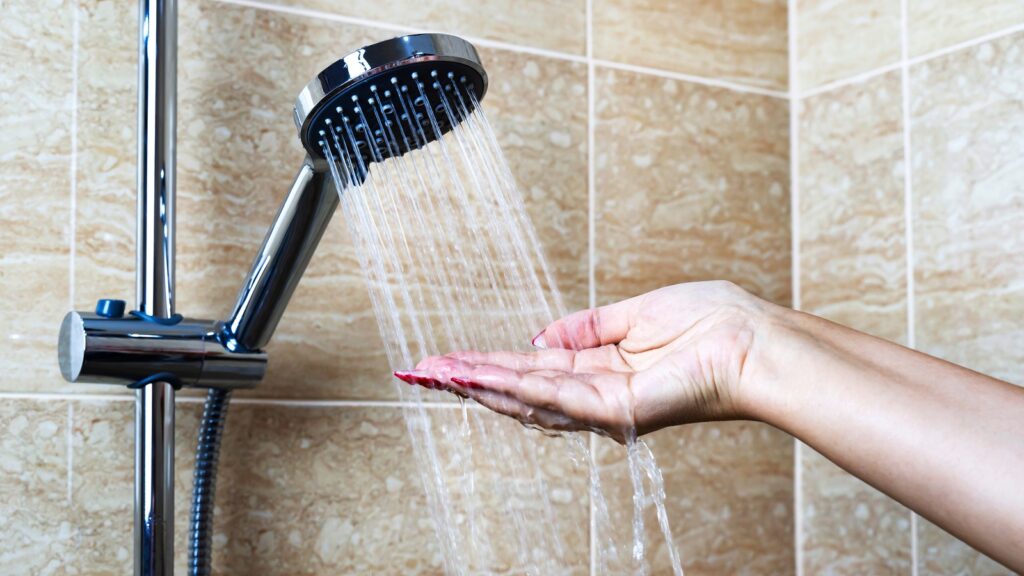It’s a chilly winter morning, and you’re ready to start your day with a hot shower. But as you turn the handle, the water comes out lukewarm—far from the steamy, comforting heat you hoped for. Frustration sets in as you wait, hoping the temperature will climb, but it barely changes. You end up shivering under the weak warmth, feeling anything but refreshed. Unfortunately, this scenario is all too common for many homeowners. The good news? You don’t have to settle for tepid showers. By identifying and fixing a few common issues, you can enjoy hotter, more satisfying showers daily.
In this article, we’ll explore how you can make your shower water hotter, from simple fixes like adjusting the water heater to more advanced solutions like installing thermostatic mixing valves. Backed by expert advice and statistics, these tips will help you find the best solution for your home.
- Check and Adjust the Water Heater Temperature
One of the most common reasons for lukewarm shower water is the water heater being too low. By default, many water heaters are set to around 120°F (49°C), a temperature recommended by the U.S. Department of Energy (DOE) to prevent scalding and save energy. However, if you prefer hotter showers, you can safely raise the temperature a few degrees. According to the DOE, increasing your water heater temperature to 140°F (60°C) can provide significantly hotter water for your showers.
To adjust the temperature:
- Locate your water heater’s thermostat (usually found near the bottom of the unit).
- Turn the dial slightly to increase the temperature.
- Wait about an hour for the water heater to adjust before testing the shower again.
Pro tip: Be cautious when increasing the temperature above 120°F to avoid the risk of scalding. If you have children or elderly individuals, a safer option might be to use a mixing valve, which we’ll discuss later.
- Insulate Your Water Heater and Pipes
Another way to ensure your shower water stays hot is by improving the insulation around your water heater and pipes. Without proper insulation, the heat from your water can dissipate as it travels through the pipes, resulting in cooler water when it reaches your showerhead.
According to the Energy Efficiency and Renewable Energy Office (EERE), 10% to 30% of heat can be lost from poorly insulated hot water tanks and pipes. Insulating your water heater with a water heater blanket and using foam pipe insulation on hot water pipes can reduce this heat loss and keep the water hotter for longer.
- Water Heater Blanket: A water heater blanket is an insulating cover that wraps around your water heater, reducing heat loss and improving energy efficiency. This small investment can lead to hotter water and lower utility bills. According to Energy Star, insulating your water heater can reduce standby heat losses by 25% to 45%, saving 7% to 16% annually on water heating costs.
- Pipe Insulation: Installing foam pipe insulation is a simple and cost-effective way to keep the heat from escaping as water travels to your shower. It’s beneficial for long pipe runs where heat loss is more significant.
- Flush Your Water Heater to Remove Sediment
Over time, sediment and minerals from hard water can build up at the bottom of your water heater, reducing its efficiency and limiting the amount of hot water it can produce. This buildup creates a barrier between the heating element and the water, meaning your water heater has to work harder to heat the water—and sometimes, the water doesn’t get as hot as it should.
According to the Water Quality Association (WQA), about 85% of U.S. households have hard water, contributing to sediment buildup. Experts recommend flushing your water heater at least once a year to keep it running efficiently. Flushing the heater helps remove sediment, ensuring it can heat water to its total capacity.
Here’s how to flush your water heater:
- Turn off the power or gas supply to the water heater.
- Connect a garden hose to the drain valve at the bottom of the tank.
- Open the valve and let the water (and sediment) drain out into a bucket or outside.
- Close the valve, refill the tank, and turn the power or gas back on.
- Adjust the Shower Valve for Maximum Heat
How to make shower water hotter? If your water heater is working correctly but your shower isn’t as hot as you’d like, the issue might be with your shower’s mixing valve. The mixing valve behind the shower handle controls the balance between hot and cold water. If it needs to be set correctly, you may get too much cold water mixed in, resulting in lukewarm showers.
Most mixing valves have a temperature adjustment feature. To adjust it:
- Remove the shower handle (this usually requires unscrewing it).
- Locate the mixing valve (you’ll typically see a small plastic or metal disc with notches or a gear).
- Adjust the valve to allow more hot water to flow through.
- Replace the handle and test your shower.
If you need help adjusting the valve, consult your shower’s manufacturer manual or hire a plumber.
- Upgrade to a Thermostatic Mixing Valve
If you frequently struggle to maintain a consistent water temperature, upgrading to a thermostatic mixing valve may be the solution. Unlike standard valves, thermostatic mixing valves automatically adjust the water temperature based on preset levels, ensuring that your shower remains steady and comfortable.
Thermostatic valves are handy in households where water temperature fluctuates due to other water usage (e.g., someone flushing the toilet or using the washing machine). A study by Angi (formerly Angie’s List) found that homeowners who installed thermostatic mixing valves reported a 25% improvement in water temperature consistency.
- Consider a Tankless Water Heater for Endless Hot Water
A tankless water heater may be the best investment for homeowners who want endless hot water without the wait. Unlike traditional water heaters, which store a finite amount of hot water, tankless systems heat water on demand, ensuring a constant hot water supply whenever needed.
According to Energy Star, tankless water heaters are 24% to 34% more energy-efficient than traditional water heaters, depending on usage. While the upfront cost of a tankless system can be higher, the long-term savings on energy bills and the ability to enjoy uninterrupted hot showers can make the investment worthwhile.
- Check for Water Heater Size and Capacity
Sometimes, the issue with lukewarm showers isn’t due to a mechanical problem but simply a mismatch between your water heater’s size and your household’s hot water demand. If you have a small water heater and multiple people shower around the same time, the hot water can run out quickly.
The U.S. Department of Energy recommends sizing your water heater based on the number of people in your household and your peak water usage times. For example, a 40- to 50-gallon tank is typically sufficient for a family of four, but larger families or homes with large bathtubs may require a larger capacity water heater.
Conclusion: Enjoy Hotter Showers with Simple Adjustments
Few things are as frustrating as stepping into a lukewarm shower, especially when the fix is often simple. From adjusting your water heater’s temperature and flushing out sediment to installing a thermostatic mixing valve or upgrading to a tankless water heater, there are many ways to boost your shower’s water temperature and improve your overall experience.
By taking these steps, you can ensure your shower is as hot and relaxing as you want—no more shivering under lukewarm water. With some maintenance and a few smart upgrades, you’ll enjoy steamy, satisfying showers daily.






